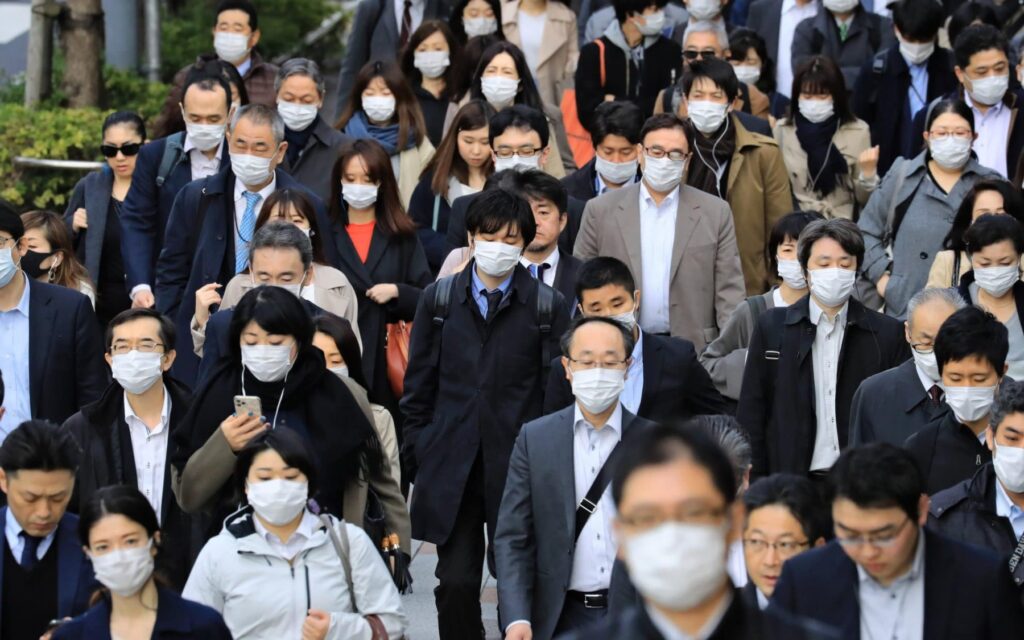

The COVID-19 virus measures only 200 nanometres in diameter, but is taking away millions of jobs across the world
Singapore, June 22, 2020
The rapidly intensifying economic effects of the COVID-19 pandemic are proving to be far worse than previous economic crises. As businesses in Asia suffer from the impacts of the pandemic, so do their 2.7 billion workers. Workers in the region have suffered from retrenchment, loss of businesses and projects, and many have been placed on unpaid leave. The impact also appears to be disproportionate, with those in vulnerable sectors and communities suffering more than others. While governments have been prompt in responding to the pandemic-induced rising unemployment through various policies, the problems faced by certain groups of workers are not addressed as adequately as others. Based on research sponsored by Microsoft, the five insights below offer a snapshot of the impacts of COVID-19 on jobs in Asia.
1. OVER HALF OF THE GLOBAL JOB LOSSES ARE EXPECTED TO BE IN ASIA
The Asia Pacific region is home to 60% of the world’s population.[1] Being the most populous region in the world, it also hosts the largest number of workers in countries with workplace closures due to the pandemic – at 1.09 billion people.[2] The International Labour Organization estimated that with layoffs and temporary reductions in working time, working hours in Asia could decline by 10% by June 2020, which is equivalent to 175 million full-time jobs (Exhibit 1). This accounts for the largest loss across regions in absolute terms and constitutes 57% of the projected global employment losses.
EXHIBIT 1
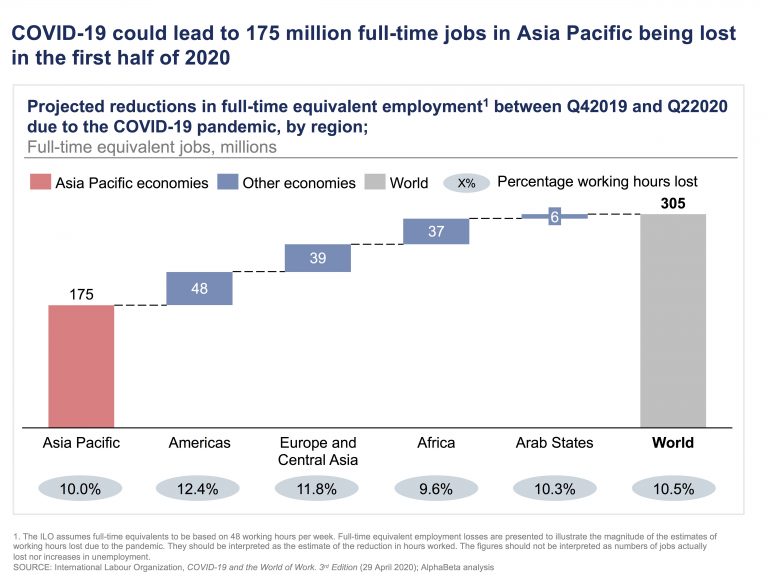

2. WHILE EVERYONE IS BEING IMPACTED BY COVID-19, THE IMPACT IS BEING FELT MOST STRONGLY BY SEVERAL COUNTRIES AND SECTORS
The Asian Development Bank has projected that countries in Asia could see potential GDP losses ranging from 5% to 8% due to the pandemic.[3] Countries differ in their containment stages of the pandemic and exposure to COVID-19-related job impacts. Although high-income economies are generally better able to contain the outbreak of the virus, they are projected to suffer more greatly in terms of job losses. This can be attributed to their high reliance on tourism and international trade, as observed for countries such as Australia and Hong Kong. Middle-income countries, on the other hand, are more varied in their ability to contain the pandemic. While the average growth rates of COVID-19 cases between the first week of May 2020 and the first week of June 2020 in China, Malaysia, Vietnam and Thailand were below 6%, India and Indonesia were recording 45% and 24% growth rates respectively.
Based on the growth in COVID-19 cases and their impact on employment, countries can be grouped into four categories (Exhibit 2). The first category includes those with high growth rates in cases such as Singapore and India, but with projected low overall impacts on job losses as a share of total employment. A second category includes countries such as China and Malaysia where both recent infection case growth rates and projected share of employment losses are relatively low. A third category includes countries where growth rates are low, but projected employment impacts are still high (this includes most developed countries such as Japan and Australia, but also emerging economies such as Thailand and Vietnam). Finally, a fourth category which includes countries where both growth rates of the virus and the impacts on employment are high (this includes Indonesia and the Philippines).
EXHIBIT 2
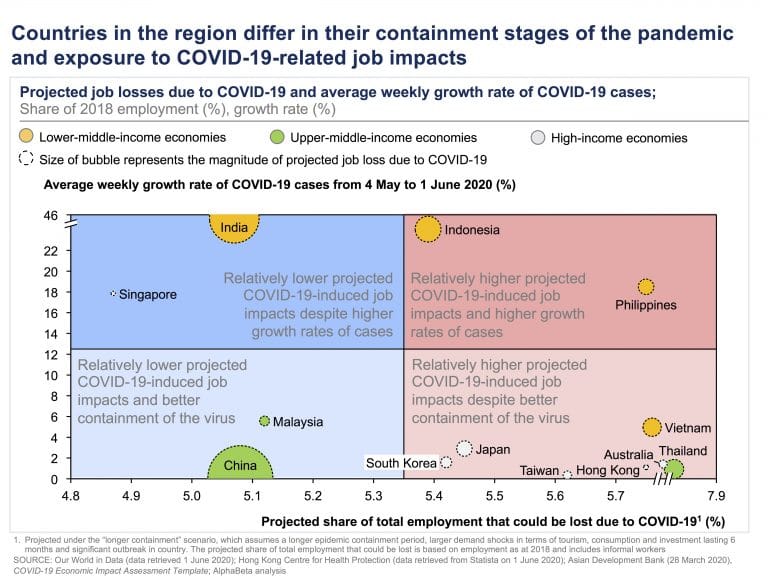

While the pandemic’s impacts on jobs are felt across all sectors, they appear to be most focused on the hotels, restaurants and transport services sectors (Exhibit 3). Countries in which these sectors account for a major share of the economy are also likely see massive job losses in these particular sectors. For example, about a quarter of jobs in both Thailand’s hotel and food services sector and Hong Kong’s transport services sector are projected to be potentially lost due to the pandemic.[4]
EXHIBIT 3
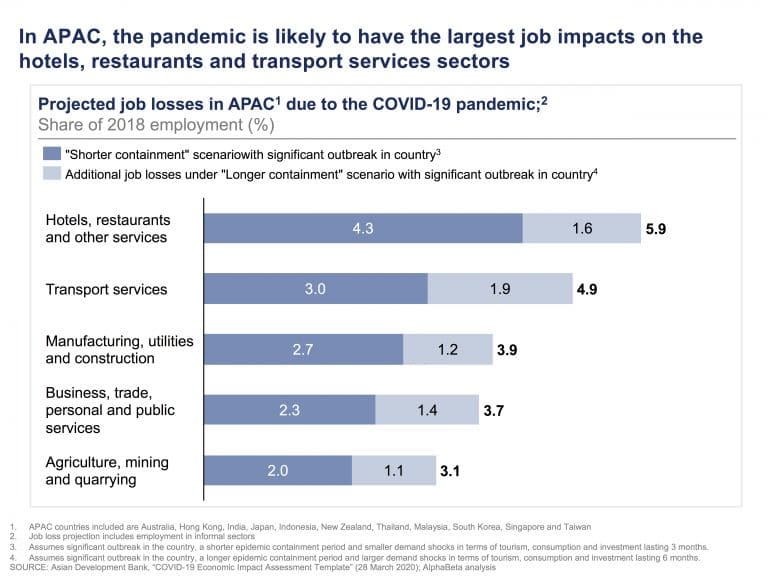

3. CERTAIN TYPES OF WORKERS ARE BEING HIT HARDEST
In the Asia Pacific region, youth, MSME (micro, small and medium sized enterprise) owners, freelance and informal workers, as well as foreign workers are likely to bear a disproportionate share of job losses due to the COVID-19 crisis. Youth, particularly graduates entering the labour force, face gloomy job market prospects as hiring activities decline. For instance, China, where an estimated 8.4 million graduates will enter the workforce this year, saw a 17% decline in the number of online job postings for fresh graduates in the first quarter of 2020 as compared to a year ago.[5i] Furthermore, freelance and informal workers whose income relies on ad-hoc projects and daily work have been seeing a drastic decline in the demand for their work. In addition to typically being accorded less priority in government COVID-19 policy, foreign workers face a range of newly imposed restrictions on work permits.
EXHIBIT 4
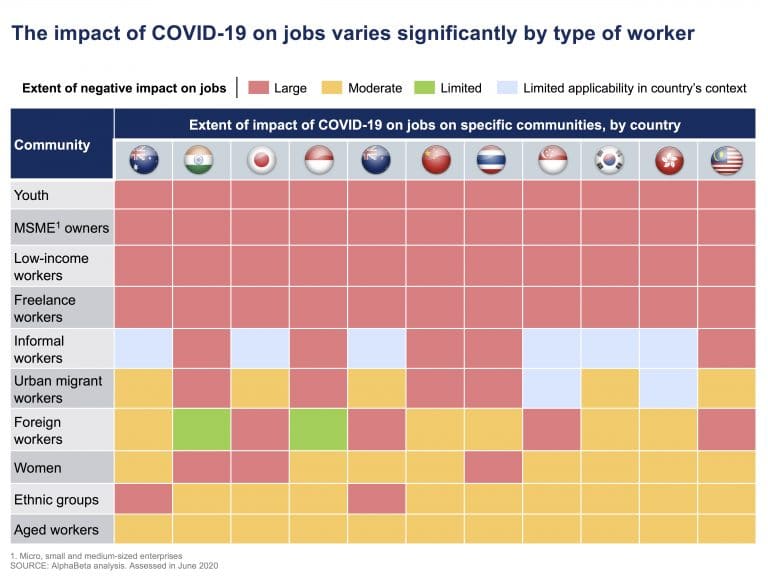

4. COUNTRIES ARE USING A VARIETY OF POLICY LEVERS TO ADDRESS THE JOB IMPACTS
To mitigate the immediate job impacts of the crisis, governments in the region are currently using a combination of eight key policy levers (Exhibit 5). These include wage support schemes, temporary employment programmes, training relief packages, financial assistance for the laid-off, job-matching platforms, online skills training programmes, measures to support digital adoption by businesses (in order to facilitate business continuity despite social restrictions) and the facilitation of business investments to create jobs.
Wage support schemes have taken various forms across countries, ranging from direct wage subsidies and wage tax reimbursements to reductions in mandatory wage-related social security contributions. Some countries further provide financial assistance to individuals who have lost their jobs, have had to take unpaid leave or had their pay cut during the crisis disbursed on a one-off basis or for a limited period of time.
Governments have also engaged in job creation through government agencies, state-owned enterprises and educational institutions to provide employment opportunities for fresh graduates and individuals that have been laid-off. Through active networking and tax incentives, some governments obtained investments in private enterprises that could further create jobs. The Singapore Economic Development Board (EDB), for instance, secured SGD 13 billion (USD 9.3 billion) of investments in the first four months of 2020 and accompanying it, additional 2,000 new jobs.[6] To ease the job searching process, some governments have launched online job-matching platforms to directly connect workers to employers. The “Keep New Zealand Working” online recruitment tool by the New Zealand Ministry of Social Development is an example of such a platform.[7]
EXHIBIT 5
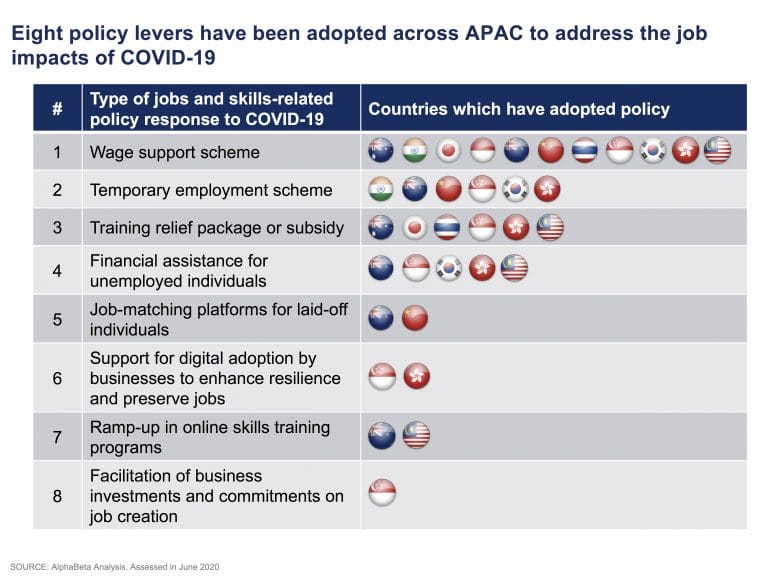

In the midst of fresh graduates facing difficulties in securing employment and workers being laid-off, policies to encourage workers to reskill and upskill themselves have also been deployed. Subsidies have been given by governments to both individuals and employers to enrol themselves or their employees in training programmes. To supplement this, some countries have ramped up their online-learning platforms to further provide training resources. In Malaysia, for example, complementing the 50% increase in training subsidies and MYR 30 daily training allowances given to workers, the Ministry of Human Resources committed MYR 2 billion (USD 468 million) to fund new and optimize existing training programmes.[8] Workers are also not the only ones encouraged to upgrade themselves. Amid the pandemic, some countries have supported enterprises to continue their business through incentivizing and/or subsidising the adoption of digital solutions. Subsidies or funding have been given to companies to undertake projects that incorporate IT solutions in their operations. For example, companies in Hong Kong, under the “Distance Business Programme”, can receive funding of up to HKD 300,000 (USD 28,700) to undertake projects aimed at developing “distance business” through IT solutions.[9] The funding covers both the costs of the solution and training expenses of employees.
5. DESPITE THESE GOVERNMENT PROGRAMMES, SEVERAL GAPS REMAIN AS SOME WORKERS TEND TO BE LEFT OUT BY EXISTING POLICIES
An analysis of the degree to which all eight policy levers have addressed high-risk communities in all countries shows that unemployed university graduates, freelance, informal and foreign workers have tended to receive less support as a result of a stronger focus on regularly-employed citizens (Exhibit 6).
EXHIBIT 6
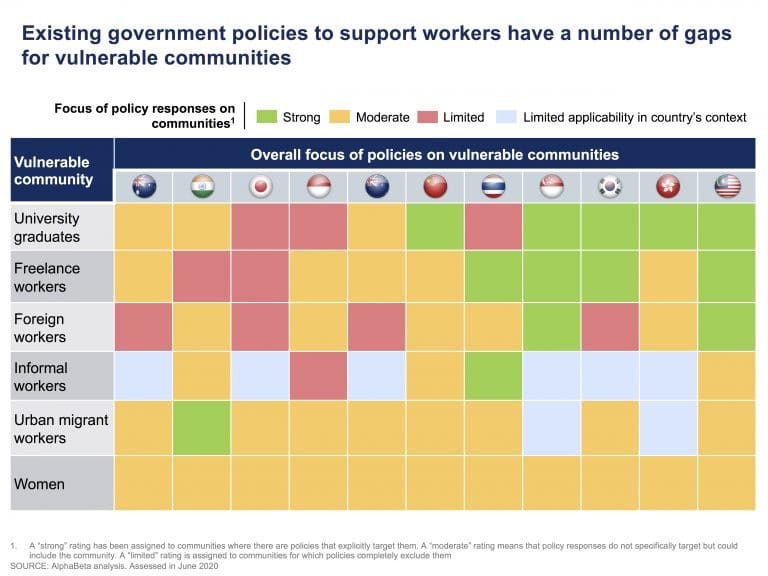

The commonly deployed wage support scheme by most countries is generally provided for workers who contribute to mandatory social security funds. However, unemployed university graduates, freelance and informal workers are excluded from this policy mechanism because they may not contribute to such funds. Foreign workers, in particular, do not typically qualify for assistance catered specifically for citizens of the country in which they are employed. At the same time, they are also excluded from support given to registered workers in their country of origin. Several countries have also started to enact restrictions – both temporary and long-term – on foreign worker entry and permits approval.
However, some countries have dedicated support programmes targeting these vulnerable communities. The support takes various forms, ranging from job opportunities created for the specific community, to financial assistance targeted to the groups that are excluded from the general policy mechanism. Workforce Singapore (WSG), for instance, rolled out the “SGUnited Traineeship Programmes” that co-fund traineeship allowances and expand the number of positions from 8,000 to 21,000 for fresh graduates.[10] In Malaysia, to support workers and spur growth in the digital freelance sector, personal mentorship, online support, and training are provided to individuals.[11] Thailand accounts for informal workers in their wage support scheme by specifically providing cash transfers to this group.[12] To ensure that companies in Singapore and Malaysia retain their foreign workers, governments in both countries have waived or reduced the monthly Foreign Workers Levy.[13]
***
The COVID-19 pandemic has created a heavy toll on the health of millions of people globally, and its economic damage could impact even far more people. AlphaBeta’s analysis shows that current efforts by governments are necessary but not sufficient to address these impacts, and more support is needed to vulnerable groups such as youth, freelance workers and informal workers. The good news is that some countries are already developing programmes to target these groups, which hopefully can provide the blueprint to inform the efforts of other countries in the region.
***
[1] Population Reference Bureau (17 September 2019), 2019 World Population Datasheet. Available at: https://www.prb.org/international/indicator/population/map/country
[2] International fur Organization (29 April 2020), ILO Monitor: COVID-19 and the world of work. 3rd Edition. Available at: https://www.ilo.org/wcmsp5/groups/public/—dgreports/—dcomm/documents/briefingnote/wcms_743146.pdf
[3] Asian Development Bank (28 March 2020), COVID-19 Economic Impact Assessment Template. Available at: https://data.adb.org/dataset/covid-19-economic-impact-assessment-template
[4] Asian Development Bank (28 March 2020), COVID-19 Economic Impact Assessment Template. Available at: https://data.adb.org/dataset/covid-19-economic-impact-assessment-template
[5] The Conference Board (May 2020), China Labor Market Review – COVID-19 Impacts and Recovery Prospects. Available at: https://conference-board.org/publications/China-Labor-Market-Review-COVID-19-Impact-and-Recovery
China Institute for Employment Research (2020), Report on the Employability of College Graduates. Available at: https://www.cier.org.cn/UploadFile/news/file/20200422/2020042222210150150.pdf
[6] The Straits Times (30 May 2020), “Thousands of jobs to be created from $13b in investment commitments secured in first 4 months of 2020: Chan Chun Sing.” Available at: https://www.straitstimes.com/singapore/thousands-of-jobs-to-be-added-as-singapore-secures-13b-in-investment-commitments-in-first
[7] New Zealand Ministry of Social Development (2020), Keep New Zealand Working. Available at: https://www.jobs-during-covid.workandincome.govt.nz/hello
[8] Malaysia Social Security Organization (2020), Employment Insurance System. Available at: https://www.perkeso.gov.my/index.php/en/benefits-of-eis/types-of-benefits
Malaysia Ministry of Human Resources (2020), Building the Economy Together. Available at: https://penjana.treasury.gov.my/pdf/PENJANA-Booklet-En.pdf
[9] Hong Kong Productivity Council (2020), Distance Business Programme. Available at: https://www.hkpc.org/en/distance-business-programme
[10] Workforce Singapore (2020), SGUnited Traineeship Programme. Available at: https://www.wsg.gov.sg/SGUnitedTraineeships-HostCompanies.html
[11] Malaysia Digital Economy Corporation Sdn. Bhd., Global Online Workforce. Available at: https://glowmalaysia.com/
[12] Bangkok Post (16 May 2020), “State readies B350bn in aid for informal workers, farmers.” Available at: https://www.bangkokpost.com/business/1918996/state-readies-b350bn-in-aid-for-informal-workers-farmers
[13] Singapore Ministry of Manpower (2020), General criteria for levy rebate and waiver. Available at: https://www.mom.gov.sg/covid-19/frequently-asked-questions/levy-rebate-and-levy-waiver
Malay Mail (6 April 2020), “Prihatin Plus cuts foreign worker levy by 25 pc, opens doors for firms to explore unpaid leave, pay cuts.” Available at: https://www.malaymail.com/news/malaysia/2020/04/06/prihatin-plus-cuts-foreign-worker-levy-by-25pc-opens-doors-for-firms-to-exp/1854059